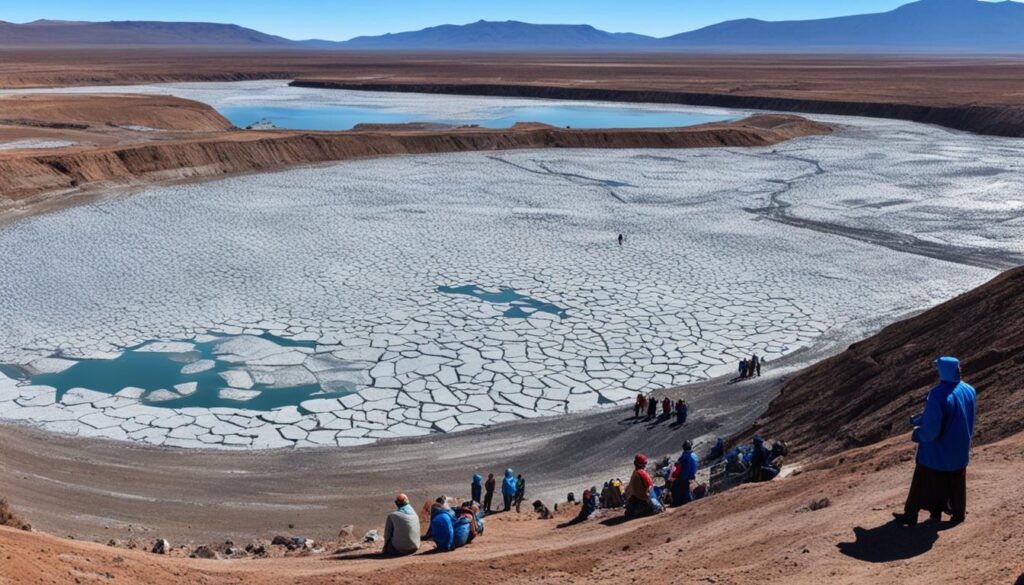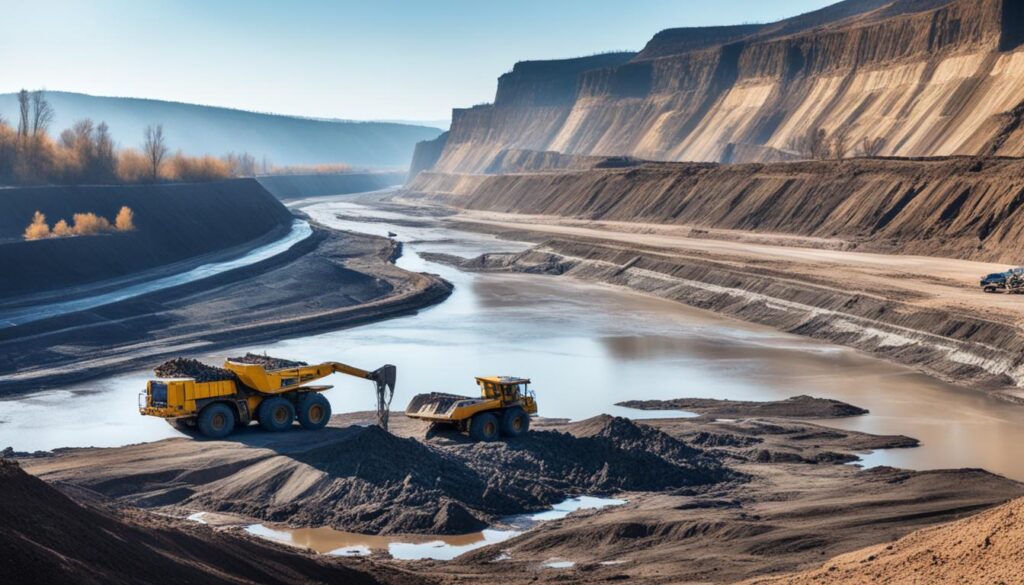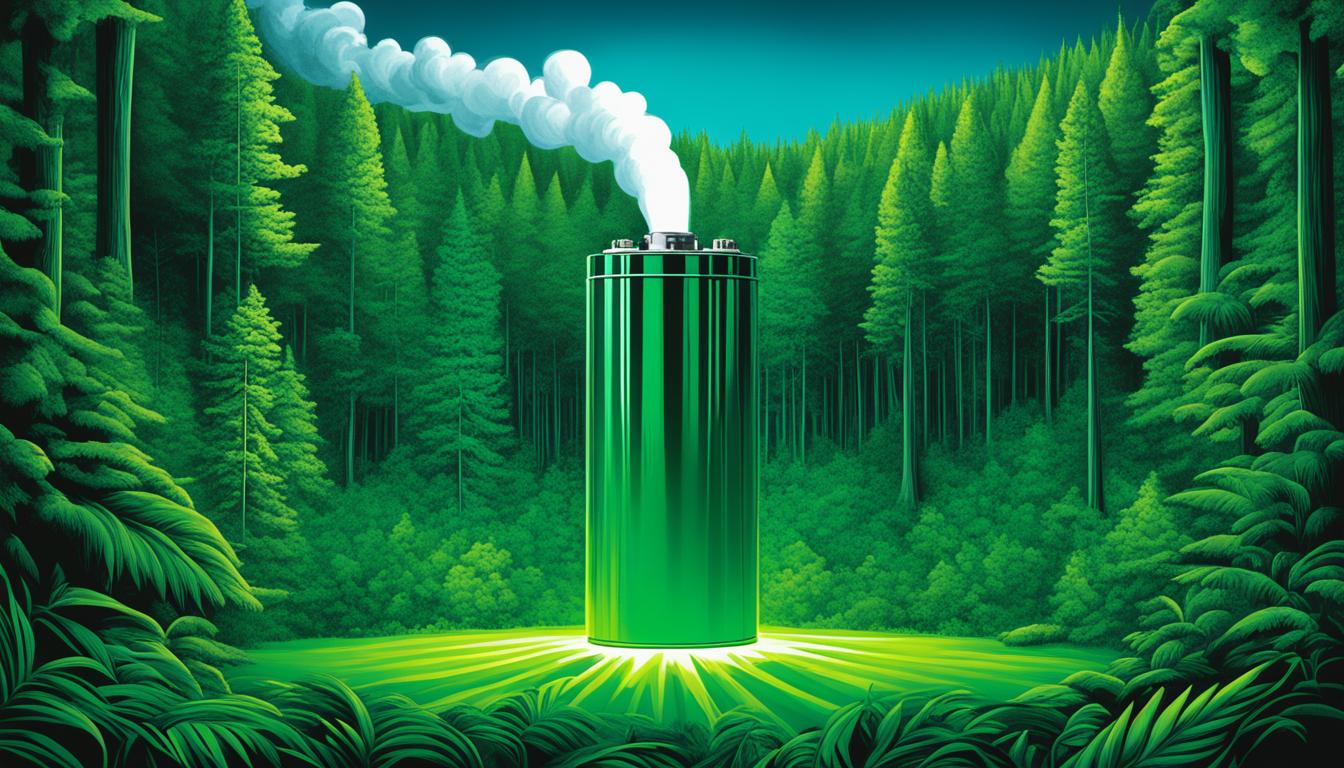The world is moving towards a sustainable future, and lithium-ion batteries are key. They power electric vehicles and renewable energy tech. But, mining lithium has big environmental costs that many don’t see. This piece will look into lithium’s true environmental effects, covering both the good and the bad sides of this important element for a greener future.
Key Takeaways
- Lithium-ion batteries are projected to account for up to 60% of new car sales by 20301
- Lithium production through evaporation ponds consumes approximately 21 million liters of water daily, requiring about 2.2 million liters of water to produce one ton of lithium1
- The Lithium Triangle, encompassing Bolivia, Argentina, and Chile, holds about 67% of the world’s known lithium reserves2
- Lithium mining has sparked controversy, with 95% of the local population in Portugal rejecting mining plans despite promised job creation1
- New battery technology research aims to replace lithium and cobalt with more environmentally friendly materials such as iron and silicon1
The Rising Demand for Lithium-Ion Batteries
Lithium-ion batteries are key to a greener future. They power electric vehicles and renewable energy tech. This has led to a huge jump in lithium demand, making the lithium market grow fast3.
Lithium’s Role in Electric Vehicles and Renewable Energy
Electric vehicles are leading the charge towards clean energy. Lithium-ion batteries are crucial for this shift. By 2030, the need for these batteries for EVs will jump from 700 GWh to about 4.7 TWh3. Battery storage systems, also using lithium-ion tech, will grow by 30 percent yearly, increasing lithium demand3.
Renewable energy like solar and wind needs lithium-ion batteries for efficient storage and distribution. As we move away from fossil fuels, the need for these batteries keeps growing.
The Unprecedented Growth of Lithium Demand
The demand for lithium-ion batteries is set to soar by over 30 percent each year. It’s expected to hit 4.7 TWh in value by 2030, making it a $400 billion market3. This growth is fueled by more electric vehicles and renewable energy tech worldwide. China will lead in lithium demand by 2025 and 2030, with Europe and the U.S. also seeing big increases3.
This demand will boost the lithium-ion battery industry, with revenues jumping from $85 billion in 2022 to over $400 billion by 20303. At least 120 to 150 new battery factories will be built by 2030 to meet this need3. The recycling of lithium batteries is also expected to grow significantly as more batteries are retired3.
The fast-growing demand for lithium-ion batteries shows how vital lithium is for a sustainable future. As we adopt electric vehicles and renewable energy, the need for efficient storage drives the lithium market’s growth.
“Lithium-ion batteries have become the backbone of the clean energy revolution, powering the transition towards a more sustainable future.”
Lithium Extraction Methods: Salt Flat Brines and Open-Pit Mining
Lithium is key for making rechargeable batteries and is mainly pulled out using two ways: salt flat brine and open-pit mining4. These methods affect the environment a lot, so we must think about them as we move towards a greener future.
In the “Lithium Triangle” of South America, salt flat brine extraction works by pumping salt water up and letting it dry in ponds, leaving behind lithium-rich brine4. This method takes up a lot of land and can leave behind harmful stuff4. Open-pit mining digs up lithium ore and then processes it for lithium4. This method also harms local ecosystems by taking up a lot of land.
Direct Lithium Extraction (DLE) is a new way that uses ion exchange to get lithium from deep underground brine water4. It’s seen as possibly needing less water because the water can go back underground after lithium is taken out4. But, DLE uses a lot of fresh water, enough for two households for a year per acre, which worries local people about water use4.
As more electric vehicles and renewable energy storage need lithium, finding ways to get it without harming the planet is key56. New tech like DLE might help, but we need to look closely at how it works and its effects to make sure we’re making the right choice for the future6.
| Extraction Method | Environmental Impact | Efficiency |
|---|---|---|
| Salt Flat Brine Extraction | Large land area usage, toxic residues | Relatively low, with significant water and energy consumption |
| Open-Pit Mining | Extensive land disturbance, ecosystem damage | Moderate, with high energy and resource requirements |
| Direct Lithium Extraction (DLE) | Concerns over fresh water usage, potential impact on water sources | Promising, with high lithium recovery rates and efficient separation, but performance in real-world conditions needs further evaluation |
As the lithium industry changes, finding a balance between getting lithium and protecting the environment will be tough6. We need new ways to extract lithium, responsible actions, and to work with communities to make sure lithium tech is good for the future.
The Environmental Impact of Lithium Mining
The demand for lithium-ion batteries is rising fast, thanks to electric vehicles and renewable energy. This has made people look closer at the effects of lithium mining on the environment7. Lithium mining, whether by salt flat brines or open-pit methods, is harming local ecosystems and communities8.
Water Depletion and Groundwater Contamination
Lithium mining uses a lot of water, which can drain and pollute local water sources7. This is bad news for the people and animals living nearby. It can ruin farming and harm the health of both humans and wildlife8.
Habitat Loss and Biodiversity Threats
Open-pit mining for lithium destroys natural habitats, leading to less biodiversity and ecosystem damage8. This can cause big problems, like losing important species and affecting the food chain. It can also hurt the environment’s overall health.
| Environmental Impact | Lithium Mining | Cobalt Mining |
|---|---|---|
| Carbon Dioxide Emissions | 1.3+ million tonnes annually9 | 1.5 million tonnes annually9 |
| Water Consumption | Significant amounts8 | Contributes to water contamination9 |
| Habitat Destruction | Disruption of natural habitats8 | Impacts on local ecosystems9 |
| Labor Issues | Concerns about labor standards8 | Reliance on artisanal miners9 |
Lithium mining’s effects on the environment are complex and need careful thought. We must balance the need for sustainable energy with protecting ecosystems and communities798.
“Lithium extraction results in the emission of around 15 tonnes of CO2 for every tonne of lithium mined, though this is significantly lower than the emissions from fossil fuel extraction.”9
As we move towards a sustainable future, we must tackle the environmental issues of lithium mining. We need to find new ways to lessen the harm to communities and ecosystems. This will help us meet the demand for renewable energy storage without harming the planet.
The “Lithium Triangle” and its Impact on Indigenous Communities
The “Lithium Triangle” in South America includes Bolivia, Argentina, and Chile. It’s where a lot of the world’s lithium is found10. This area is also home to many indigenous communities. Their lives have changed a lot because of the growing need for lithium11.
Lithium prices have gone up a lot, reaching $76,000 per ton in China11. This has led to more mining, which is a problem for the indigenous people. It’s taken away their clean water and changed their traditional ways of living.
The Struggle for Water Access and Traditional Ways of Life
Lithium mining in the “Lithium Triangle” has been hard on indigenous communities10. It uses a lot of water, needing 500,000 gallons for every ton of lithium made10. In Chile’s Salar de Atacama, mining has taken 65 percent of the water, leaving the local people without it10.
Indigenous leaders are worried about the environment and not being asked about mining plans11. The mining has split communities, with young people leaving their old ways for mining jobs11. In Argentina, right-wing policies have made it easier for mining companies, which is bad for indigenous land11.

Lithium mining can create jobs and improve infrastructure, but it’s had a big impact on indigenous communities11. They’re fighting for their water and way of life in the “Lithium Triangle.”11 As the demand for lithium keeps going up12, the future of these communities is uncertain. We need a better way to get resources without hurting them111210.
The Toxic Legacy of Lithium Mining
Lithium-ion batteries are in high demand, leading to more lithium mining. But this mining harms the environment. It uses up water and can pollute local water sources13.
Lithium mining uses dangerous chemicals like hydrochloric acid. These chemicals can leak into rivers, lakes, and groundwater13. This pollution hurts ecosystems and the health of people who depend on these waters for drinking, farming, and everyday life.
Chemical Leaks and Pollution in Local Water Sources
Lithium mining’s harm goes beyond just using up water. It also pollutes with chemicals. These chemicals can get into nearby water, causing pollution and harm to communities13.
- Around 2.2 million liters of water are needed to produce one ton of lithium. Replacing 1.5 billion petrol-powered vehicles would need about 15 million tons of lithium, which is like 33 trillion liters of water13.
- About 77% of the world’s Li-ion batteries are made in China, where coal is the main energy source13.
- Only around 9% of lithium-ion batteries are recycled, with the rest going to landfills13.
- It’s estimated that 11 million tons of Li-ion batteries will need to be replaced by 203013.
The harm from lithium mining is growing as demand for lithium-ion batteries increases. We need to address these issues to make sure moving to clean energy is good for everyone.
“The environmental impact of lithium mining is not limited to water depletion; the industry also faces the challenge of chemical contamination.”
is lithium really green ?
The world is moving towards a sustainable future, and lithium-ion batteries are key for electric vehicles and renewable energy storage. But, concerns about the environmental effects of lithium mining make us wonder if it’s really a green choice16.
Lithium mining, through salt flat brine or open-pit methods, causes environmental problems. It leads to water loss, contaminated groundwater, destroyed habitats, and threats to biodiversity17.
| Extraction Method | Environmental Impact | Recovery Rate |
|---|---|---|
| Brine Extraction | Water depletion, groundwater contamination | 97% |
| Hard-Rock Mining | Habitat loss, biodiversity threats, high CO2 emissions | 94% |
Electric vehicles powered by lithium are seen as a greener choice than gasoline cars. But, we can’t overlook the environmental harm from lithium mining16. The making of batteries and the need for other minerals like cobalt and nickel add to the problem18.
The question “is lithium green?” is now more complex. We must weigh the good of lithium tech against its environmental harm17. Creating sustainable lithium mining and looking into new battery types are key to a green energy future.

“The environmental cost of lithium mining cannot be overlooked in the pursuit of a sustainable future. We must find a balance between the benefits of lithium-powered technologies and their environmental impact.”
The Environmental Cost of Other Battery Components
Lithium mining’s environmental impact is well-known, but the story doesn’t end there. Cobalt and nickel, key parts of lithium-ion batteries, also have big environmental and social costs19.
The Harmful Effects of Cobalt and Nickel Mining
In the Democratic Republic of Congo, cobalt mining raises serious environmental and human rights concerns. It’s responsible for 40% of the climate impact from making lithium-ion batteries19. Huge amounts of fresh water are used, causing water shortages in dry areas19. Also, two types of flamingos in Chile are at risk because of lithium mining19.
Nickel mining is also dangerous, leading to habitat loss and toxic releases. The need for nickel has grown with the demand for lithium-ion batteries. This has caused social issues and protests in places like Indonesia19. Indigenous communities there face problems like marginalization and economic exploitation from mining19.
Traditional knowledge from indigenous people is key to protecting nature and saving species. But, mining has harmed their way of life, affecting fish and endangered flamingos in Chile’s Salars De Atacama19.
We need to look at the environmental and social costs of mining battery components. We must work towards renewable energy and electric vehicles in a way that protects communities and nature19.
“The environmental footprint of lithium-ion batteries must be examined holistically, considering the impact of all their constituent materials.”
Exploring Sustainable Alternatives to Lithium Batteries
Researchers are looking into new battery types to lessen the environmental harm. These new batteries could lessen the issues with lithium mining and still help us move to a greener future20.
Aluminum-ion batteries are a new hope, charging much faster than old lithium-ion ones20. Silicon-based lithium batteries also stand out, holding 20% more energy and taking up less space20.
Magnesium-based batteries are another option, carrying more charge than lithium or sodium. They offer more energy, are stable, and cheaper20. Hemp-based batteries from Bemp Research are also in the mix, aiming to be cheaper, lighter, and better for the planet20.
Sodium-ion batteries are another choice, with lots of sodium around and lower costs21. They’re safer and easier to recycle than lithium-ion, making them a solid option21.
| Battery Technology | Energy Density | Cycle Life | Cost | Environmental Impact |
|---|---|---|---|---|
| Lithium-ion | 200-300 Wh/kg | Longer | Higher | Higher carbon emissions, water depletion, and toxicity |
| Sodium-ion | 150-160 Wh/kg | Shorter | Lower | Lower emissions, less toxic, and easier to recycle |
| Aluminum-ion | N/A | N/A | N/A | Lower environmental impact than lithium-ion |
| Silicon-based Lithium | 20% more than lithium-ion | N/A | N/A | Lower environmental impact than lithium-ion |
| Magnesium | Higher than lithium or sodium | N/A | Lower | Lower environmental impact than lithium-ion |
| Hemp-based | N/A | N/A | Lower | Lower environmental impact than lithium-ion |
The table shows how new battery types are better for the planet than old lithium-ion ones. Even if they might not hold as much energy or last as long, they’re better for the environment2021.
As we move to renewable energy and electric cars, we need better batteries. These new options could help reduce the harm from making and using batteries202122.
“The future of energy storage lies in the development of sustainable, high-performance battery technologies that can reduce the environmental impact of the current lithium-ion dominance.”
By trying out these new, green batteries, we can make the battery industry better for our planet202122.
The Ethical Dilemma: Balancing Clean Energy and Environmental Justice
The push for clean energy and sustainability through lithium-ion batteries raises tough questions. These questions come from the environmental and social costs of lithium mining. These costs mainly hit indigenous and marginalized communities hard23. These groups have always looked after the land but often can’t protect their rights or traditional life23.
It’s vital to include indigenous communities in decisions about lithium mining and sustainable energy. This is key for real environmental justice.
The Role of Indigenous Communities in Environmental Preservation
Lithium mining is tough on miners, with bad working conditions, long hours, and low pay in places with weak rules23. It also uses a lot of water, which can harm local ecosystems and water sources23. This hurts indigenous communities who have lived there for generations, changing their way of life and putting their future at risk.
But, these communities’ voices are often ignored in decisions that affect their lands23. It’s important to listen to them and use their knowledge for a fair and green energy shift.
Some countries have a lot of key minerals, causing tensions and unfairness around the world23. We need a big plan that looks at indigenous rights and the big effects of mining and clean energy.
“The renewable energy transition risks leaving traditional energy sector workers, such as coal miners and oil rig workers, with uncertain futures, emphasizing the need for support programs and economic diversification.”23
Dealing with the ethical issues of clean energy and justice is hard. It needs a team effort from leaders, industries, green groups, and indigenous communities. Together, we can make sure a greener future helps everyone, not just some242523.
Conclusion
Lithium mining and the making of lithium-ion batteries have big environmental effects. These technologies could help us live more sustainably, but they also harm our water, destroy habitats, and pollute with chemicals26. To make a real change, we need to look at the whole picture. We must find ways to mine lithium that don’t harm the planet and listen to the people who live there.
The demand for lithium-ion batteries is expected to jump from US$30 billion in 2017 to $100 billion by 202527. This shows we need to act fast. The European Union wants to use more recycled lithium in batteries27. But, there’s not enough recycled material and recycling batteries is expensive27. We should focus on reusing batteries and creating greener ones to lessen the harm they cause.
We must find a balance between clean energy and protecting the environment for everyone26. We can’t ignore the harm caused by lithium mining and the opinions of indigenous communities26. By using new, green ways to solve problems, we can make sure lithium technology helps us without hurting our planet or people.
FAQ
What is the demand for lithium-ion batteries?
What are the primary methods of commercial lithium extraction?
What are the environmental impacts of lithium extraction?
How does lithium mining affect indigenous communities in the “Lithium Triangle” region?
What are the risks of chemical contamination from lithium mining?
Is lithium a truly “green” solution for the energy transition?
What are the environmental and social costs of other battery components?
What are some sustainable alternatives to lithium-ion batteries?
How can the ethical dilemma of clean energy and environmental justice be addressed?
Source Links
- South America’s ‘lithium fields’ reveal the dark side of electric cars
- The Harmful Effects of our Lithium Batteries
- Battery 2030: Resilient, sustainable, and circular
- Living on Earth: Lithium from Deep Underground
- Lithium and the New Green Extractionism – THE MOJAVE PROJECT
- Environmental impact of direct lithium extraction from brines – Nature Reviews Earth & Environment
- Lithium mining for EVs: How sustainable is it? — APM Research Lab
- The Social and Environmental Impacts of Lithium Mining
- The Environmental Impacts of Lithium and Cobalt Mining
- The Lithium Triangle: Where Chile, Argentina, and Bolivia Meet
- Indigenous Communities Face Water Crisis Amid Lithium Mining Boom
- Native groups sit on a treasure trove of lithium. Now mines threaten their water, culture and wealth
- Where Do Lithium-Ion Batteries Go When They Die? You’re Not Going to Like the Answer
- Of Life and Lithium – resilience
- Lithium Mining Is Leaving Chile’s Indigenous Communities High and Dry (Literally)
- How Green Are Electric Vehicles? (Published 2021)
- The new ‘gold rush’ for green lithium
- Environmental impacts of lithium-ion batteries
- The cost of green energy: lithium mining’s impact on nature and people
- Sustainable Alternatives to Lithium Use in Batteries
- Sodium batteries: A better alternative to lithium?
- Alternatives to Lithium Ion Batteries
- The Ethical Dilemmas of Renewable Energy Development
- Green Energy Needs Green Storage – Science in the News
- Environmental Impacts of Lithium-Ion Batteries – IER
- Lithium-ion batteries need to be greener and more ethical

